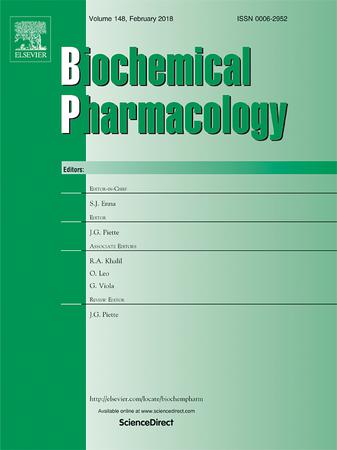Cuproptosis involvement in neonatal ischemic-hypoxic encephalopathy through the COMMD1/ATP7A signaling axis
IF 5.3
2区 医学
Q1 PHARMACOLOGY & PHARMACY
引用次数: 0
Abstract
Neonatal hypoxic-ischemic encephalopathy (HIE) is a severe brain lesion caused by perinatal asphyxia that often results in neonatal death or long-term neurological deficits. The in-depth study of cell death mechanisms has recently led to the discovery of cuproptosis, a new type of cell death. Although understanding the relationship between HIE and cuproptosis is still in its preliminary stages, there is evidence that copper ions and their associated metabolic pathways play an important role in the pathophysiology of HIE. We used the Rice-Vannucci method to construct a mouse model of HIE. Cerebral infarct volume was measured by 2,3,5-triphenyltetrazolium chloride staining and pathological changes in brain tissue were examined by hematoxylin and eosin and Nissl staining. The levels of cuproptosis indicators and of key proteins, Copper Metabolism MURR1 domain protein 1 (COMMD1) and ATPase Copper Transporting Alpha (ATP7A), in the signaling axis related to cuproptosis were determined by western blotting. Mitochondrial morphology was observed by transmission electron microscopy, and copper salt staining and a copper ion probe were used to detect copper ion levels. Methyl thiazolyl tetrazolium (MTT) assays were used to measure neuronal survival. Our results indicate that cuproptosis occurs during neonatal ischemia and hypoxia, and that cuproptosis can regulate the occurrence and development of neonatal ischemic-hypoxic encephalopathy through the COMMD1/ATP7A signaling axis. This study provides new understanding of neonatal ischemic-hypoxic encephalopathy and indicates targets for the development of therapeutics.
comd1 /ATP7A信号轴参与新生儿缺血-缺氧性脑病
新生儿缺氧缺血性脑病(HIE)是一种由围产期窒息引起的严重脑部病变,常导致新生儿死亡或长期神经功能缺损。随着对细胞死亡机制的深入研究,近年来发现了一种新的细胞死亡类型——铜增生。虽然对HIE与铜畸形之间关系的了解尚处于初步阶段,但有证据表明铜离子及其相关代谢途径在HIE的病理生理中起重要作用。采用Rice-Vannucci方法建立小鼠HIE模型。采用2,3,5-三苯四唑氯化染色法测定脑梗死体积,苏木精染色、伊红染色及尼氏染色法观察脑组织病理变化。western blotting检测与铜裂相关的信号轴上铜裂指标及关键蛋白铜代谢MURR1结构域蛋白1 (COMMD1)和ATPase Copper transportalpha (ATP7A)水平。透射电镜观察线粒体形态,铜盐染色和铜离子探针检测铜离子水平。甲基噻唑四氮唑(MTT)测定神经元存活率。本研究结果提示新生儿缺血缺氧时铜体畸形发生,铜体畸形可通过COMMD1/ATP7A信号轴调控新生儿缺血-缺氧脑病的发生和发展。本研究为新生儿缺血性缺氧性脑病提供了新的认识,并为治疗的发展指明了靶点。
本文章由计算机程序翻译,如有差异,请以英文原文为准。
求助全文
约1分钟内获得全文
求助全文
来源期刊

Biochemical pharmacology
医学-药学
CiteScore
10.30
自引率
1.70%
发文量
420
审稿时长
17 days
期刊介绍:
Biochemical Pharmacology publishes original research findings, Commentaries and review articles related to the elucidation of cellular and tissue function(s) at the biochemical and molecular levels, the modification of cellular phenotype(s) by genetic, transcriptional/translational or drug/compound-induced modifications, as well as the pharmacodynamics and pharmacokinetics of xenobiotics and drugs, the latter including both small molecules and biologics.
The journal''s target audience includes scientists engaged in the identification and study of the mechanisms of action of xenobiotics, biologics and drugs and in the drug discovery and development process.
All areas of cellular biology and cellular, tissue/organ and whole animal pharmacology fall within the scope of the journal. Drug classes covered include anti-infectives, anti-inflammatory agents, chemotherapeutics, cardiovascular, endocrinological, immunological, metabolic, neurological and psychiatric drugs, as well as research on drug metabolism and kinetics. While medicinal chemistry is a topic of complimentary interest, manuscripts in this area must contain sufficient biological data to characterize pharmacologically the compounds reported. Submissions describing work focused predominately on chemical synthesis and molecular modeling will not be considered for review.
While particular emphasis is placed on reporting the results of molecular and biochemical studies, research involving the use of tissue and animal models of human pathophysiology and toxicology is of interest to the extent that it helps define drug mechanisms of action, safety and efficacy.
 求助内容:
求助内容: 应助结果提醒方式:
应助结果提醒方式:


